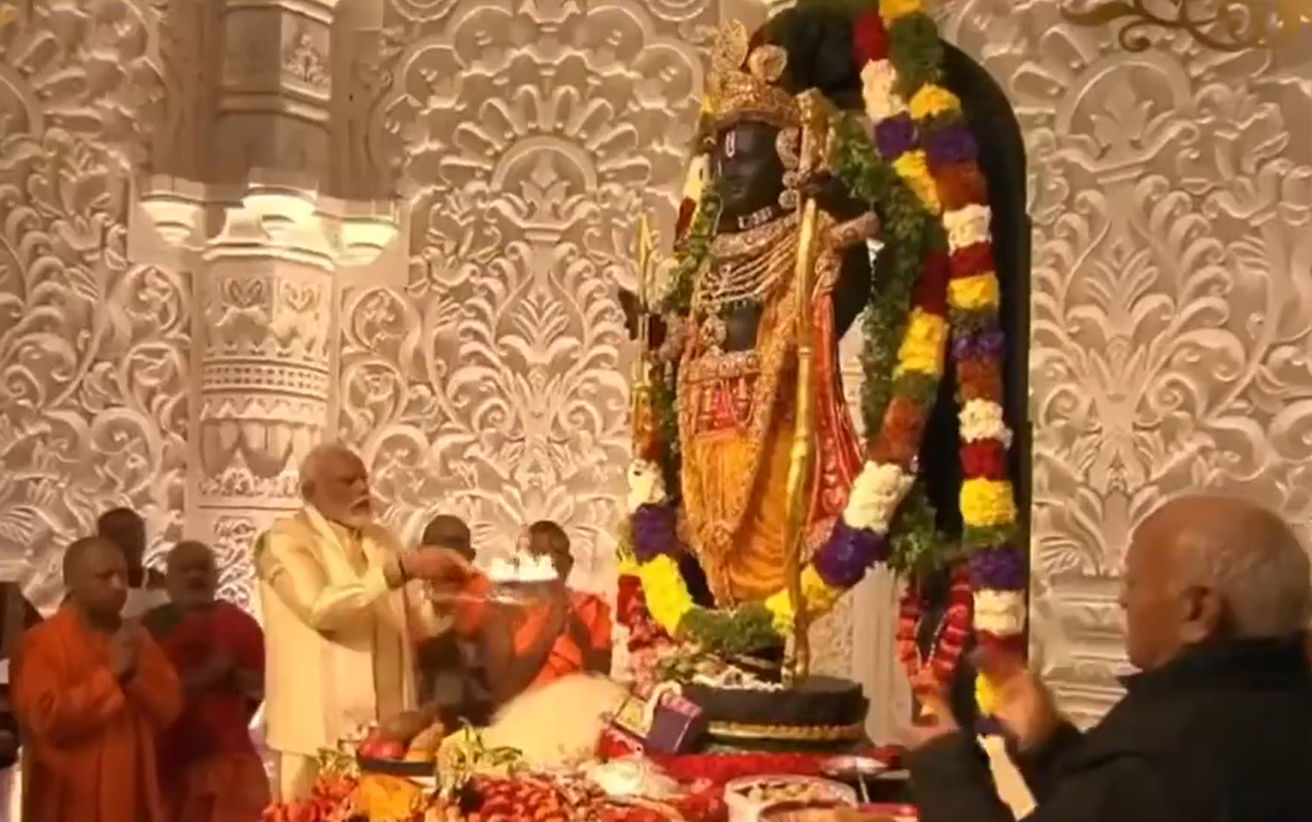Ayodhya's day: the bishop of Lucknow hopes it will inspire ‘brotherhood’, not political confrontation
The Ram Mandir, the new temple symbol of India in the place disputed with Muslims, has been officially consecrated. For Indian Prime Minister Narendra Modi, “our Lord Ram has finally arrived,” marking “the beginning of a new era”. Bishop Mathias hopes that the “Ram Rajya (Reign of Rama) that Mahatma Gandhi dreamt of for our beloved country” will be realised. Today also marks 25 years since Rev Staines and his two sons were burnt alive in one of the most brutal acts of religious violence in the country's recent history.
Ayodhya (AsiaNews) – India today saw the consecration of the Ram Mandir, the monumental temple in Ayodhya desired by Hindu nationalists at the site where, according to Hindu tradition, the god Ram was born.
“The consecration and inauguration of Ram Temple in Ayodhya is a matter of joy for millions of Ram bhaktas or devotees of Lord Ram,” said Bishop Gerald Mathias of Lucknow, a large city in Uttar Pradesh, speaking to AsiaNews about the event.
“I wish and pray that this ceremony and inauguration will also inaugurate the Ram Rajya that Mahatma Gandhi dreamt of for our beloved country. Ram Rajya or the Kingdom of God is characterised by the divine and human values of justice, peace, love, brotherhood, tolerance, and religious harmony.
The solemn ceremony, which represents a personal triumph for Indian Prime Minister Narendra Modi, comes at the end of the long controversy with Muslims whose Babri mosque stood at the same site, but was razed to the ground by Hindu fundamentalists in 1992 in an event that triggered a spiral of communal violence that cost thousands of deaths.
The new Hindu temple was built after a long court legal battle that saw the Supreme Court of India ultimately award the site to Hindus in 2019, but also provided for the construction of a mosque at a nearby site.
The temple was built on a grand scale. In terms of size, it now becomes the largest Hindu place of worship in India and the third largest in the world after the Angkor Wat complex in Cambodia and the Swaminarayan Mandir in New Jersey.
It was designed to accommodate up to a million people at any one time, with the ambition of exceeding the number of visitors who travel to the Vatican and Makkah every year.
Sculptors and craftsmen were called upon from all over India to contribute to its realisation.
For this occasion, Prime Minister Modi said that he had prepared himself with 11 days of fasting to mark the solemnity of the moment.
“Lord Ram has finally arrived (in his abode) following the wait of centuries,” he said in very emphatic tones. “After the patience that we showed for centuries and the sacrifices we made, our Lord Ram has finally arrived,” he added.
“January 22, 2024, is not just a date, but the beginning of a new era,” he declared. “The construction of Ram Mandir has filled people with a new energy,” so that the country can break free from “the shackles of slave mentality” thanks to “Ram's supreme blessings”.
The bishop of Lucknow warns, however, against the dangers of politicising religion. In his view, “This event should not polarise people but unite [them] as brothers and sisters.”
Sadly, “politicians have taken advantage of the temple issue and are in the forefront while the Shankaracharyas are left behind. They are bound to take political milage out of it.
“Prime Minister Narendra Modi said that ‘the construction of Ram Temple is an instrument to unite the country’. May his dream be realised and may all work towards its realisation by peaceful coexistence,” the prelate said.
Bishop Mathias also pointed out that Ayodhya has a church and “the Canossian Sisters also have a big school not far from the temple. I am sure that they will and should continue to serve people without any interference and will be an example for all, of religious tolerance, harmony, and peace.”
A warning against using Ayodhya to further extremism also comes from Jesuit Fr M. K. George, marking a singular coincidence.
On Matters India, an Indian Catholic news platform, the clergyman notes that today is the 25th anniversary of the odious murder in Odisha (Orissa) of Rev Graham Staines, an Australian Evangelical pastor who was burnt alive along with his two sons on 22 January 1999 in one of the most brutal killings carried out by Hindu fanatics in India’s recent history.
The two events, the temple’s consecration and the multiple murders reminded Fr George of some of Rabindranath Tagore’s verses:
“There is no God in the temple, says the Saint.
The angry King retorts, ‘There is no God! Oh! Saint, you talk like an atheist. The gleaning idol made with rare gems, sitting on the golden throne- Is that empty space?’
“It is not empty, it is filled with royal hubris’, says the Saint.
“You have installed yourself, Not the Master of the World”.
For this reason, “January 22 should become a day of self-examination for all the citizens and believers of India.”







.png)










